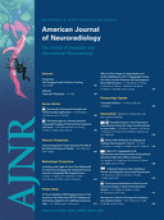Abstract
BACKGROUND AND PURPOSE: Endovascular TVE for DCCF is used for curative purposes, but serious complications can be caused with inadequate embolization. Our aim was to report clinical characteristics, angiographic findings, and results of endovascular TVE in patients presenting with DCCF.
MATERIALS AND METHODS: We performed a retrospective analysis of 44 consecutive patients with DCCF treated by TVE. Approach routes, angiographic results, clinical outcomes, and complications were assessed.
RESULTS: An approach via the internal jugular vein and inferior petrosal sinus was possible in 90% of patients, with complete occlusion of the fistula in 81.6% of patients. A minor residual shunt remained in 13.6% of patients, while a significant shunt remained in 4.5%. In 4 patients, add-on management with transarterial embolization was useful, and in 2 patients with residual shunt, radiosurgery was used. With long-term follow-up (6–40 months), we encountered recanalization/recurrence in 4 patients (9.1%). Complications were seen in the form of permanent morbidity in 3 patients (7%) and transient morbidity in 6 patients (14%).
CONCLUSIONS: For endovascular treatment of DCCF, a transvenous approach was effective in most of our patients; however, some adverse effects were encountered. If AV shunts remain after transvenous treatment, additional modalities must be considered.
Abbreviations
- AV
- arteriovenous
- B
- Barrow type B
- Bilat.
- bilateral
- CN
- cranial nerve
- CS
- cavernous sinus
- D
- Barrow type D
- DCCF
- dural carotid-cavernous fistula
- ECA
- external carotid artery
- ICA
- internal carotid artery
- ICH
- intracerebral hemorrhage
- IPS
- inferior petrosal sinus
- Lt.
- left
- Rt.
- right
- SOV
- superior ophthalmic vein
- SPS
- superior petrosal sinus
- TVE
- transvenous embolization
- Copyright © American Society of Neuroradiology
Indicates open access to non-subscribers at www.ajnr.org












